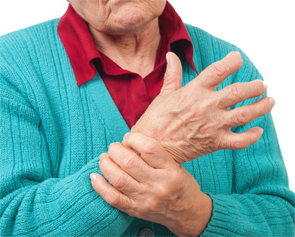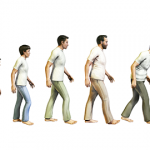
Studies indicate that a number of modifiable targets exist that we can focus on to help prevent the onset of widespread pain in older adults.
Hriana/shutterstock.com
SAN FRANCISCO—A broadening of the medical community’s horizons in how pain is regarded and treated in older adults, including those with osteoarthritis and other rheumatic diseases, is sorely needed, a researcher said at the 2015 ACR/ARHP Annual Meeting.
Incidence
Studies show that a large percentage of older adults each year see physicians for such issues as lower back pain and knee pain, and research shows that pain correlates with less healthy aging in older adults. Yet it is an area that is relatively little studied, said Ross Wilkie, PhD, research fellow in epidemiology at Keele University in the U.K.
His remarks were made in a session that also included a look at the way the pain is viewed in the U.S., and U.S. initiatives in trying to improve pain-related healthcare and research.
Dr. Wilkie discussed data out of Scotland that show the extremely high rate at which older adults see doctors for pain. Over 90% of women between 55 and 64 visit a doctor for lower back pain each year, according to National Services Scotland.1 About 70% of men in that age group see a doctor for that reason. Data for knee pain were similar.
Studies have also shown that older adults often have pain issues in multiple areas, Dr. Wilkie said.
“We know that with age pain accumulates, and over time, people begin to have two or more problems,” he said. One study found that almost 50% of women age 60 or older reported pain at four or more sites.2
Pain & Healthy Aging
Dr. Wilkie and his team have studied the link between pain and healthy aging—a look at the overall “success” in aging that factors in cognitive, physical and mental well-being, social participation and quality of life.3 Examining data from nearly 3,000 study participants with a median age of 61, researchers found that having a higher rate of pain at baseline correlated with a worse score on the Healthy Aging Index. Furthermore, as pain increased, so did the worsening of the index scores.
“People who came into the study with pain had aged less successfully up until baseline, and the more pain that people had, the more unsuccessfully they aged,” Dr. Wilkie said.
The study also found that pain seems to affect women more severely than it does men: When women have pain, they tend to age in a manner that is less healthy than men with pain do.
A reasonable goal stemming from these findings, Dr. Wilkie said, is to find ways to prevent musculoskeletal conditions and pain before old age arrives.
A subsequent study at his center found that the strongest predictor of widespread pain was non-restorative sleep, with those reporting non-restorative sleep on most nights almost twice as likely to have widespread pain compared with those who don’t report regular non-restorative sleep. That was followed by anxiety, with those reporting definite anxiety having about a 50% higher chance of having widespread pain compared with those without anxiety.4
“Our work indicates that there’s also a number of modifiable targets that we can actually focus on that can prevent the onset of widespread pain in older adults,” Dr. Wilkie said.
He also pointed to data showing that as adults get older they are less and less likely to receive physical therapy, but more likely to receive medical therapy, in spite of the higher risk of complications from those medications.
Dr. Wilkie suggested that the first point of contact for pain in older adults should perhaps be a physical therapist while acknowledging that such an arrangement might not be as feasible in some countries as it is in others.
“Curing pain is not very much the goal,” he said. “Improving an individual’s ability to cope and to maintain their function should be the targets of our interventions.”
National Focus
Charles Helmick, MD—senior medical epidemiologist with the Arthritis Program at the Centers for Disease Control’s National Center for Chronic Disease Prevention and Health Promotion—said that national attention on the problem of pain is growing in the U.S.
A report by the Institute of Medicine in 2011 shined a spotlight on the issue, saying, among other things, that the collection and reporting of data on pain need to be improved; a national population-minded strategy on pain prevention and treatment needs to be developed; the ability of people to self-manage pain needs to be improved; education about pain for primary care providers needs to be improved; better research strategies are needed for the development of new agents; and longitudinal research on pain needs to be conducted.
Over 90% of women between 55 & 64 visit a doctor for lower back pain each year, according to National Services Scotland.1 About 70% of men in that age group see a doctor for that reason.
Dr. Helmick said the report was also a call for cultural transformation in how we think about pain, which “can be invisible to people.”
“Pain should be treated as a disease in its own right,” he said. “Just like if you have hypertension or diabetes, if you have pain, it’s a disease in its own right, no matter how you got there. It should be treated that way.”
A National Pain Strategy, currently being tweaked before publication, is intended to help decrease the prevalence of pain of all kinds and to make it more feasible for people to get “timely access” to a care system that suits them.
The project that developed the strategy was organized into six workgroups on population research, prevention and care, disparities in pain experience and treatment, service delivery and reimbursement, professional education and training, and public education and communication.
Part of the problem in addressing pain care is that it is an issue infused with competing incentives. For example, opioids are needed, but there is an opioid mortality epidemic underway; there is certainly overtreatment, but there is also undertreatment, and there is a tension between primary care providers and pain specialists, Dr. Helmick said.
“The primary care providers want to do the right thing, but they don’t know where to turn for their help,” he said. “There are not a lot of resources out there that I know of.”
Thomas R. Collins is a medical writer based in Florida.
References
- ISD Scotland. General practice—Practice Team Information (PTI). 2011 Feb 22.
- Thomas E, Peat G, Harris L, et al. The prevalence of pain and pain interference in a general population of older adults: Cross-sectional findings from the North Staffordshire Osteoarthritis Project (NorStOP). Pain. 2004 Jul;110(1–2):361–368.
- Wilkie R, Tajar A, McBeth J. The onset of widespread musculoskeletal pain is associated with a decrease in healthy ageing in older people: A population-based prospective study. PLoS One. 2013;8(3):e59858.
- McBeth J, Lacey RJ, Wilkie R. Predictors of new-onset widespread pain in older adults: Results from a population-based prospective cohort study in the UK. Arthritis Rheumatol. 2014 Mar;66(3):757–767.


